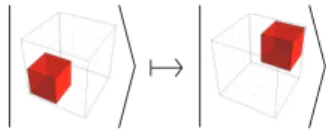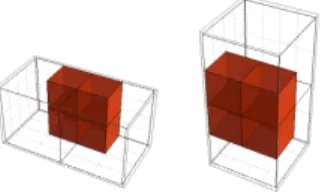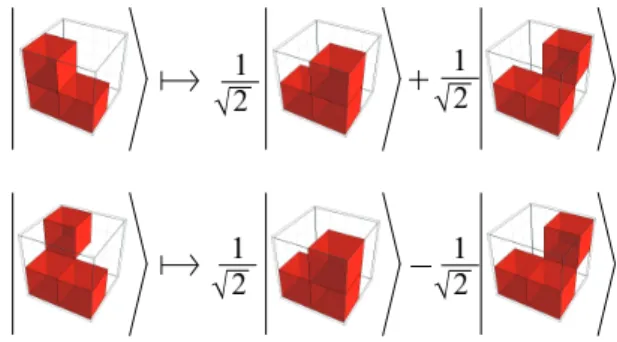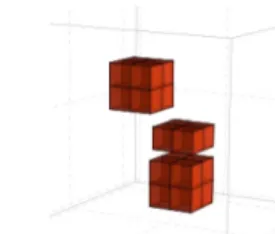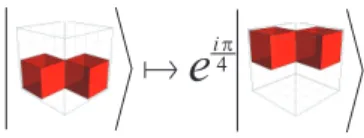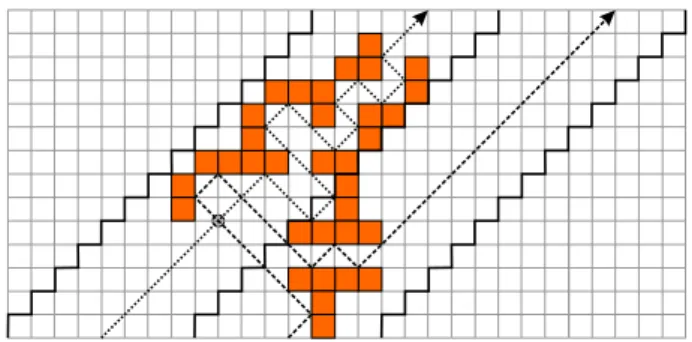HAL Id: hal-00542373
https://hal.archives-ouvertes.fr/hal-00542373
Submitted on 3 Dec 2010
HAL is a multi-disciplinary open access archive for the deposit and dissemination of sci-entific research documents, whether they are pub-lished or not. The documents may come from teaching and research institutions in France or abroad, or from public or private research centers.
L’archive ouverte pluridisciplinaire HAL, est destinée au dépôt et à la diffusion de documents scientifiques de niveau recherche, publiés ou non, émanant des établissements d’enseignement et de recherche français ou étrangers, des laboratoires publics ou privés.
Pablo Arrighi, Jonathan Grattage
To cite this version:
Pablo Arrighi, Jonathan Grattage. A Quantum Game of Life. Journées Automates Cellulaires 2010, Dec 2010, Turku, Finland. pp.31-42. �hal-00542373�
PABLO ARRIGHI 1 AND JONATHAN GRATTAGE 2 1 Universit´e de Grenoble, LIG
E-mail address: pablo.arrighi@imag.fr URL: http://membres-lig.imag.fr/arrighi
2 Ecole Normale Sup´erieure de Lyon, LIP´
E-mail address: jonathan.grattage@ens-lyon.fr URL: http://www.grattage.co.uk/jon
Abstract. This research describes a three dimensional quantum cellular automa-ton (QCA) which can simulate all other 3D QCA. This intrinsically universal QCA belongs to the simplest subclass of QCA: Partitioned QCA (PQCA). PQCA are QCA of a particular form, where incoming information is scattered by a fixed uni-tary U before being redistributed and rescattered. Our construction is minimal amongst PQCA, having block size 2 × 2 × 2 and cell dimension 2. Signals, wires and gates emerge in an elegant fashion.
1. Introduction
(Quantum) Cellular Automata. Cellular automata (CA), first introduced by von Neumann [41], consist of an array of identical cells, each of which may take one of a finite number of possible states. The entire array evolves in discrete time steps by iterating a function G. This global evolution G is shift-invariant (it acts the same everywhere) and causal (information cannot be transmitted faster than some fixed number of cells per time step). Because this is a physics-like model of computation [21], Feynman [18], and later Margolus [22], suggested early in the development of quantum computation (QC) that quantising this model was important. This was for two main reasons. Firstly, in QCA computation occurs without extraneous (unnecessary) control, hence eliminating a source of decoherence, which is problem for QC implementation. Secondly, they are a good framework in which to study the quantum simulation of a quantum system, which is predicted to be a major application of QC. From a Computer Science perspective there are other reasons to study QCA, such as studying space-sensitive problems in computer science (e.g. ‘machine self-reproduction’, ‘Firing Squad Synchronisation’, . . . ) in the quantum setting, or having more complete and formal models of physics ability to compute. There is also the theoretical physics perspective, where CA are used as toy models of quantum space-time [20]. The first approach to defining QCA [2, 16, 42] was later superseded by a more axiomatic approach [9, 10, 35] together with more operational approaches [12, 27, 32, 33, 39, 42].
Key words and phrases: cellular automata, quantum computation, universality.
Intrinsic universality. Probably the most well known CA is Conway’s ‘Game of Life’, a 2D CA which has been shown to be universal for computation, in the sense that any Turing Machine (TM) can be encoded within its initial state and then executed by evolution of the CA. As TM are often regarded as a robust definition of ‘what an algorithm is’ in classical computer science, this provides a key result in CA research. However, more can be achieved using CA than just running any algorithm. They run distributed algorithms in a distributed manner, model phenomena together with their spatial structure, and allow the use of the spatial parallelism inherent to the model. These features, modelled by CA and not by TM, are all worthy of investigation, and so the concept of universality should be revisited in this context to account for space. This is achieved by returning to the original meaning of the word universality [1, 11, 13], namely the ability for one instance of a computational model to be able to simulate other instances of the same computational model. Intrinsic universality formalises the ability of a CA to simulate another in a space-preserving manner [23, 30, 37], and has been extended to the quantum setting [4, 6, 7]. In previous work [7] it was shown that, when the dimension of space is greater than one, the problem of intrinsic universality reduces to the ability to code for signals, wires and a universal set of quantum gates, as expected from the classical CA case [30].
Related work. There are several related results in the current CA literature. For example, several works [21, 25, 26] provide computation universal Reversible Parti-tioned CA constructions, and [24] deals with their ability to simulate any CA in the one-dimensional case. The problem of minimal intrinsically universal CA has been addressed [31], and for Reversible CA (RCA) the issue of intrinsic universality has been tackled [14, 19]. The difficulty is in having an n-dimensional RCA simulate all other n-dimensional RCA and not, say, the (n − 1)-dimensional RCA, otherwise a history-keeping dimension could be used, as shown by Toffoli [38]. Concerning QCA, Watrous [42] proved that QCA are universal in the sense of QTM. Shepherd, Franz and Werner [36] defined a class of QCA where the scattering unitary Ui changes at
each step i (CCQCA). Universality in the circuit-sense has been achieved by Van Dam [39], Cirac and Vollbrecht [40], Nagaj and Wocjan [27] and Raussendorf [33]. In the bounded-size configurations case, circuit universality coincides with intrinsic universality, as noted by Van Dam [39]. QCA intrinsic universality in the one-dimensional case has been resolved [5], and also in the general n > 1-one-dimensional case [7]. Both results rely on recent work [6], where it was shown that a simple sub-class of QCA, namely Partitioned QCA (PQCA), are intrinsically universal. This enables the focus here to be on this simple, natural class of QCA, as previously pro-posed ([33, 35, 39, 42] etc. ). PQCA are QCA of a particular form, where incoming information is scattered by a fixed unitary U before being redistributed and rescat-tered. Hence the problem of finding an intrinsically universal PQCA is reduced to finding some scattering unitary U that supports the implementation of signals, wires and a universal set of quantum gates.
Game of Life. As the more general case of finding a general n-dimensional intrin-sically universal QCA has been resolved [6], one could question the necessity of focusing on the particular 3D case of this problem. Our answer to this question is threefold.
• In the study of models of computation, the definition of the model is often followed by the search for a universal instance, and then for a minimal uni-versal instance. Reaching this final step is generally regarded as a sign of maturity of the model. It shows that the entire model can be reduced to a particular simplest instance. Moreover, sometimes a particular instance stands out, either for its elegance and simplicity, or the richness of its be-haviour. This was clearly the case with the Game of Life within the realm of Classical CA, and it is echoing this impression that we have named this QCA the ‘Quantum Game of Life’. This is not because of a resemblance in the construction of the local rule, which clearly owes more to the Billiard Ball Model CA [19].
• Dimension three is particularly interesting, not only because of the relevance to physics, but because intrinsic universality QCA constructions lend them-selves to a striking simplification. In dimension one the simplest known intrinsically universal QCA has cell dimension 36 [5]. In dimension two it has cell dimension 4 [7], and seems reducible to 3 via a costly and inelegant variation of the scheme [7], but probably no further. The solution we present here is in dimension three and has cell dimension 2; it is therefore minimal. • Animations of the QCA operating, plus an implementation of this QCA, are available on the companion website [8]. Although it lacks a friendly way of preparing the initial configuration, it turns out to be quite interesting and entertaining already, as is the Game of Life. We plan to implement the QCA in a more graphical, interactive, computationally efficient fashion. The end result could be a pedagogical tool, both for discussing quantum theory and in order to start exploring the dynamical behaviour of QCA, such as in [28], perhaps using methods inspired by similar work on Probabilistic CA [34].
2. The Universal QCA
Definitions. Configurations hold the basic states of an entire array of cells, and hence denote the possible basic states of the entire QCA:
Definition 2.1 (Finite configurations). A (finite) configuration c over Σ is a func-tion c : Z3
−→ Σ, with (i1, i2, i3) 7−→ c(i1, i2, i3) = ci1,i2,i3, such that there exists a (possibly empty) finite set I satisfying (i1, i2, i3) /∈ I ⇒ ci1,i2,i3 = q, where q is a distinguished quiescent state of Σ. The set of all finite configurations over Σ will be denoted CΣ
f.
As this work relates to QCA rather than classical CA, the global state can be a superposition of these configurations. To construct the separable Hilbert space of superpositions of configurations the set of configurations must be countable. This is why finite, unbounded, configurations are considered; the quiescent state of a CA is analogous to the blank symbol of a TM tape.
Definition 2.2 (Superpositions of configurations). Let HCΣ
f be the Hilbert space of configurations. Each finite configuration c is associated with a unit vector |ci, such that the family (|ci)c∈CΣ
f is an orthonormal basis of HC Σ
f. A superposition of configurations is then a unit vector in HCΣ
Figure 1: Signals propagate diagonally across the partition.
Detailed explanations of these definitions, as well as axiomatic definitions of QCA, are available [9, 10, 35]. Building upon these works, we have shown [6, 7] that Partitioned QCA (PQCA) are intrinsically universal. Since they are the most canonical description of QCA, and since the aim of this paper is to construct the most canonical, and yet universal, QCA, we will assume that all QCA are PQCA throughout this work.
Definition 2.3 (Partitioned QCA). A partitioned three-dimensional quantum cel-lular automaton (PQCA) is defined by a scattering unitary, a unitary operator, U such that U : H⊗2Σ 3 −→ H⊗2
3
Σ , and U |qq . . . qqi = |qq . . . qqi, i.e. that takes a cube
of 23
cells into a cube of 23
cells and preserves quiescence. Consider G = (N
2Z3U), the operator over H. The induced global evolution is G at odd time steps, and σG at even time steps, where σ is a translation by one unit in all directions.
Here we provide a specific instance of a U-defined PQCA which is capable of intrinsically simulating any V -defined PQCA, for any V . In order to describe such a U-defined PQCA in detail, two things are required: the dimensionality of the cells (including the meaning attached to each of the states they may take); and the way in which the scattering unitary U acts upon these cells.
2.1. Signals and wires
Classical CA studies often refer to ‘signals’ without an explicit definition. In this context, a signal refers to the state of a cell which may move to a neighbouring cell consistently, from one step to another, by the evolution of the CA. Therefore a signal would appear as a line in the space-time diagram of the CA.
The U-defined PQCA constructed in this paper is minimal, in the sense that it is a 3D PQCA with the smallest non-trivial block-size and cell-dimension. Hence, each cell has only two possible states, either empty or occupied; it is a binary automaton, with scattering unitary U acting on 2 × 2 × 2 cell neighbourhoods (a cube). The description of the scattering unitary U that defines the behaviour of the automaton will now be provided in a case by case manner.
2.1.1. Signals. Signals in our scheme will be encoded as isolated occupied cells. If a neighbourhood trivially contains no signals, then no change is made. If a neighbourhood contains only one signal, i.e. only one cell is occupied, and the other seven are empty, then the signal is shifted by one in every direction, yielding a 3D diagonal propagation. This rule is given in Fig. 1. These two rules, together with their rotations, define the action of the scattering unitary U upon the subspace with zero or one occupied cells. Notice that U can easily be seen to be unitary upon this subspace, as it performs a permutation of the basis states.
Figure 2: Two occupied cells which share one face form a static barrier.
Figure 3: Two vertical barriers placed in adjacent partitions horizontally form a 2 × 2 × 1 barrier (left). At the next time step, the repartitioning is still stable, with two horizontal barriers in adjacent vertical partitions formed from those same cells (right).
Figure 4: Four occupied cells occupying a face of the partition neighbourhood form a wall.
2.1.2. Barriers. Two or more occupied cells that share a common face form a barrier, which is intended to be a stationary pattern. The rule is given in Fig. 2. Such a barrier is stable for one partition, but in the next partition it appears as two signals moving away from each other, and hence it will scatter. This can be avoided by extending beyond the current partition, using at least four occupied cells. For example, a 2 × 2 × 1 block of cells which overlaps a partition and forms a barrier in each partition, as shown in Fig. 3, is stable. This rule, together with its rotations, defines the action of the scattering unitary U upon the subspace of two adjacent occupied cells. Upon this subspace the scattering unitary U acts like the identity, which is unitary.
2.1.3. Walls. When two barriers, made of four occupied cells, form a square that fits within a partition, as in Fig. 4, we say that they form a wall. A wall is able to redirect a fifth occupied cell, that shares only one face with the wall, which represents the incoming signal. Again a wall in one partition appears as signals moving away from each other in the next partition, but again they can be made stable following Fig. 3, by extending them across partitions. The behaviour required is for an incoming signal to “bounce” off the wall, and the rule producing this behaviour is given in Fig. 5. This rule suffices to define signal redirection, or “rewiring”. These rules, together with their rotations, define the action of the scattering unitary U upon the subspace of walls and walls with a signal. Notice that U is unitary upon this subspace, as it performs a permutation of the basis states.
Figure 5: A signal which interacts with a wall in a neighbourhood “bounces” off the wall, causing it to change direction along one axis. Compare with the unhindered signal propagation shown in Fig. 1.
Figure 6: Qubits are implemented as parallel tracks of signals. No qubit is modelled as no signal (left), |0i is modelled as a signal on the lower track (centre), while a signal on the upper track models a qubit in state |1i (right).
Figure 7: The rules implementing the Hadamard operation. The first gives |0i 7→
1
√2|0i + √12|1i while the second gives |1i 7→ √12|0i − √12 |1i.
2.2. Qubits and quantum gates
To allow a universal set of gates to be implemented by the PQCA, certain com-binations of signals and barriers need to be given special importance. To implement qubits, pairs of signals will be used. Indeed in our scheme a qubit is formed by two parallel “tracks” of signals, as shown in Fig. 6. A signal on the bottom track indicates a |0i state, whereas the top track indicates a |1i state. Qubits in super-positions are modelled by appropriate supersuper-positions of the configurations, as in Def. 2.2. We can now define rules which implement quantum gates on those qubits1
. 2.2.1. Hadamard. The Hadamard gate is a requirement for universal quantum com-putation, where H : |0i 7→ 1
√2|0i +√12|1i , |1i 7→ √12|0i −√12|1i. In order to achieve
this typically quantum behaviour, a special meaning is attached to the interaction of a signal with a single two-cell barrier (as defined in section 2.1.2). The corresponding rule is given by Fig. 7.
1
In Quantum Mechanics, a qubit can be encoded into any 2 degrees of freedom of a system. Some experiments in quantum optics, for example, use the spin degree of freedom, whereas others use a spatial degree of freedom. This model is analogous to the latter case. See the conclusion section for a discussion of relevance to physical systems.
Figure 8: A stable Hadamard configuration, formed by two barriers extended across partitions (left). The Hadamard configuration can be extended with two cubed “walls”. The first cube, on the top left, redirects the top track |1i signal, incoming from the bottom left and travelling to the far top right, into the barrier. The second cube, bottom right, redirects the output bottom |0i track so that it is again moving parallel to the |1i track, keeping the qubit representation consistent (right).
As all the rules we provide are rotation invariant, the unambiguity of the Hadamard rule may not be clear. To be unambiguous, the |0i and |1i cases need be to distinguished from each other, and the signal distinguishable from the barrier. This can be done as follows: if the cube can be rotated such that all three signals are on a single face, forming an “L” shape, then the input to the Hadamard is |0i, and the signal is at the top of the L. If instead a lone occupied cell is on the top left of the furthest face, with a two-cell barrier along the bottom of the closest face, forming a dislocated L shape, then the input to the Hadamard is |1i and the signal is the isolated, top left cell.
On its own, a barrier is not enough to implement the Hadamard gate, because it does not respect the parallel track convention of qubits defined earlier. Rather, inputs and outputs are orthogonal. To rectify this, the barrier can be combined with two walls, which redirect the signals appropriately, as shown in Fig. 8. Further rewiring can be added so the qubit can arrive and leave in any direction, but these are not easily represented in 2D projections.
These two rules, together with their rotations, define the action of the scattering unitary U upon the subspace of two-cell barriers plus a signal. Notice that U is unitary upon this subspace, as it is a composition of a Hadamard gate upon the input states, together with the permutation of the basis states that perform the movement described in Fig. 7.
2.2.2. Controlled rotations. A two qubit controlled gate is another requirement for universal quantum computation, and in this case we choose the controlled-R(π
4)gate,
where cR(π/4): |11i 7→ eiπ4 |11i, and is the identity otherwise. To encode a two qubit controlled gate, signal collisions, where two moving signals cross each other diagonally, will be interpreted as adding a global phase of eiπ4. This rule is given by Fig. 9.
This allows a controlled-R(π
4) operation to be defined, by redirecting the |1i
(true) signal track so that the tracks will cross each other in this way, and then recreating the qubits by rejoining the |1i tracks back with the appropriate |0i tracks, using walls to redirect and delay signals as in the Hadamard case. Again, this 3D configuration cannot easily be presented in 2D.
e
i !4Figure 9: When two signals cross each other diagonally, a complex phase is added to the configuration state.
This same rule can also be used to implement a single qubit phase change op-eration by causing a control signal to loop such that it will intersect with the true track of the qubit, thus adding the global phase to the configuration. This needs to be correctly timed so that the tile implementing the single qubit rotation can be iterated, following the same reasoning as in [7].
This rule defines, together with its rotations, the action of the scattering unitary U upon the subspace of two non-adjacent signals on face. U can again be seen to be unitary upon this subspace, as it is a permutation of the basis states, with a phase. 2.3. Universality, erosion and dynamics
We have seen that the scattering unitary U is a unitary on the subspaces upon which it has been defined. Additionally, following arguments given previously [7], it may be concluded that the U-defined PQCA given here is intrinsically universal:
• In space dimension greater than one, it suffices to implement signals, wires and a universal set of gates to achieve intrinsic universality;
• The controlled-R(π
4) and the Hadamard gate are universal for Quantum
Computation.
Indeed the standard set of cNot, H, R(π
4) can be recovered as follows:
cNot |ψi = (I ⊗ H)(cR(π/4))4
(I ⊗ H) |ψi
where cR(π
4) 4
denotes four applications of the controlled-R(π
4) gate, giving the
controlled-Phase operation.
We could let the action of the scattering unitary U be the identity in all other subspaces. However, some patterns would then be unmovable and indestructible, such as the wall of Fig. 4. This would arguably make the dynamics of the QCA presented here a little plain. Moreover, since walls could be built through simulta-neous signal collision, it would be natural to be able to dismantle them. If we are interested in the dynamics, different ways of completing the definition of U upon the remaining subspaces should be considered. A natural way is to consider that all of the other cases are made of non-interacting signals, where the occupied cells propagate past each other diagonally. This allows, for instance, for the demolition of walls and the creation of new stable patterns.
Animated examples and an implementation of this cellular automaton can be found online [8]. We hope to explore its dynamics in future simulations.
3. Comparison with Two-Dimensional Rules & Tiles
In previous work we provided a generic construction of an n-dimensional in-trinsically universal QCA [7]. In this section we will compare the two dimensional instance given previously with the scheme presented here.
Figure 10: The 2D ‘controlled-R(π
4) gate’ tile, with a signal interaction at the
high-lighted cell.
Objects. In [7] the cell-dimension is 4. A cell can be either empty, a wall, or a binary signal (0 and 1). In a sense the same objects are recovered in the scheme presented here, but as the cell dimension is 2 these are conveyed as patterns of cells. Walls are now coded as 22
squares as in Fig. 4. Signals no longer have a bit attached to them; instead the location of the signal is used to encode this bit of information. Rules. Once the above observations have been made; it can be seen that the two dimensional, cell-dimension four scheme previously described [7] is almost a projection of the scheme presented here. Indeed:
- the 2D signal travelling rule of [7]; s 7→ s , is a height-projection of the corresponding rule in Fig. 1;
- the 2D signal bouncing rule; s 7→ s , again a height-projection of the corresponding rule in Fig. 5;
- the 2D control-phase rule; 1 1 7→ eiπ4 1 1 , x y 7→ y x otherwise, is a width-depth projection of the corresponding rule in Fig. 9;
- only the 2D Hadamard rule of [7] differs slightly: 0 7→ √1 2 0 +√1 2 1 1 7→ √1 2 0 − √1 2 1
Tiles. Previously, not only were the above rules provided, but a set of fixed-sized (16 × 14) tiles, taking a fixed number of time steps (24) to be travelled through, and each accomplishing one of the universal quantum gates upon the incoming signals were also given [7]. The example of the controlled-R(π
4) tile is reproduced in Fig. 10
for concreteness. The difference between such tiles and the corresponding rule (the controlled-R(π
4) rule in this case) is that tiles need only to be placed next to one
another so as to make up a circuit, with all signal wiring and synchronisations being accounted for. It would be cumbersome to describe the equivalent of all these tiles in the scheme presented here, particularly due to their 3D nature. Some are shown on the companion website [8]. The reader may convince himself of their feasibility through the following arguments: since those tiles exist in 2D, and since the 2D
rules are projections of the 3D rules, there must exist some 3D tiles for which the 2D ones are, in some sense, projections.
4. Conclusion
This paper presents a minimal 3D PQCA which is capable of simulating all other PQCA, preserving the topology of the simulated PQCA. This means that the initial configuration and the forward evolution of any PQCA can be encoded within the initial configuration of this PQCA, with each simulated cell encoded as a group of adjacent cells in the PQCA, i.e. intrinsic simulation. The main, formal result of this work can therefore be stated as:
Claim 4.1. There exists an 3D U-defined PQCA, with block size 2 and cell dimen-sion 2, which is an intrinsically universal PQCA. Let H be a 3-dimendimen-sional V -defined PQCA such that V can be expressed as a quantum circuit C made of gates from
the set Hadamard, Cnot, and R(π
4). Then G is able to intrinsically simulate H.
Any finite-dimensional unitary V can always be approximated by a circuit C(V ) with an arbitrary small error ε = max|ψi||V |ψi − C |ψi ||. Assuming instead that G simulates the C(V )-defined PQCA, for a region of s cells over a period t, the error with respect to the V -defined PQCA will be bounded by stε. This is due to the general statement that errors in quantum circuits increase, at most proportionally with time and space [29]. Combined with the fact that PQCA are universal [7, 6], this means that G is intrinsically universal, up to this unavoidable approximation.
Discussion. This PQCA is definitely minimal amongst the 3D PQCA. Reducing the block size or the cell dimension necessarily results in a trivial PQCA. Moreover, PQCA are the simplest and most natural class of QCA [3]. Nevertheless, it is not so clear that this PQCA is minimal amongst all intrinsically universal 3D QCA. Indeed, PQCA-cells are really QCA-subcells, and PQCA-blocks need to be composed with them shifted in order to yield the QCA neighbourhood. Based on these observations our QCA has QCA-cell dimension 28
and the 3D radius–1
2 neighbourhood. Whether
there are some further simplifications in this more general setting is an open question. An important source of inspiration, along with the original Game of Life, was the the simplest known intrinsically universal classical Partitioned CA [22], which has cell dimension 2. Called the BBM CA, it was itself directly inspired by the Bil-liard Ball Model [19]. Our scheme also features signals (bilBil-liard balls, or particles) bouncing and colliding. This analogy with physics is a desirable feature; Feynman’s sole purpose for the invention of QC [17] was that quantum computers would be able to simulate quantum systems efficiently, and hence predict their behaviour. It is still thought that quantum simulation will be one of most important uses of quantum computers for society, with expected and potentially unexpected impact in quan-tum chemistry, biochemistry or nanotechnologies (e.g. in terms of the synthesis of specific purpose molecules). This was also one of the reasons why Feynman immedi-ately promoted the QCA model of QC [18]; they are a natural mathematical setting in which to encode the continuous-time and space, sometimes complex, behaviour of elementary physical elements (such as wave equations of particles, possibly in-teracting, under some field, for example) into the more discrete-data discrete-time framework of quantum computation. This issue of encoding is non-trivial, but has largely been solved for the one-dimensional case, by using QCA as a mathematical framework in which to model the system of interest. For example, several works
simulate quantum field theoretical equations in the continuous limit of a QCA dy-namics (such as [32], etc. ) These results do not extend to more-than-one dimensions due to the problem of isotropy. Whilst in one-dimension the division of space into a line of points is an acceptable model, because it does not privilege the left over the right direction, in two-dimensions the grid seems to inevitably favour the cardinal directions (N, E, S, W) over the diagonal ones. That this construction is similar to the Billiard Ball Model CA suggests a Quantum Billiard-Ball Model could be defined, moving away from the underlying grid, which would remedy this problem. This is planned this for future work.
Acknowledgements
The authors would like to thank J´erˆome Durand-Lose, Jarkko Kari, Simon Mar-tiel, Kenichi Morita, Guillaume Theyssier and Philippe Jorrand.
References
[1] J. Albert and K. Culik. A simple universal cellular automaton and its one-way and totalistic version. Complex Systems, 1:1–16, 1987.
[2] P. Arrighi. Algebraic characterizations of unitary linear quantum cellular automata. In
Pro-ceedings of MFCS, LNCS, volume 4162, page 122. Springer, 2006.
[3] P. Arrighi. Quantum cellular automata. Th`ese d’habilitation `a diriger les recherches, Univer-sity of Grenoble, 2009.
[4] P. Arrighi and R. Fargetton. Intrinsically universal one-dimensional quantum cellular au-tomata. In Proceedings of DCM, 2007.
[5] P. Arrighi, R. Fargetton, and Z. Wang. Intrinsically universal one-dimensional quantum cel-lular automata in two flavours. Fundamenta Informaticae, 21:1001–1035, 2009.
[6] P. Arrighi and J. Grattage. Partitioned quantum cellular automata are intrinsically universal. Accepted for publication, Post-proceedings of the Physics and Computation workshop, 2009. [7] P. Arrighi and J. Grattage. A Simple n-Dimensional Intrinsically Universal Quantum Cellular
Automaton. LATA 2010, LNCS, 6031:70–81, 2010.
[8] P. Arrighi and J. Grattage. Companion website: www.grattage.co.uk/jon/3DQCA, 2010. [9] P. Arrighi, V. Nesme, and R. Werner. Unitarity plus causality implies localizability. QIP 2010
and Journal of Computer and System Sciences, ArXiv preprint: arXiv:0711.3975, 2010.
[10] P. Arrighi, V. Nesme, and R. F. Werner. Quantum cellular automata over finite, unbounded configurations. In Proceedings of MFCS, LNCS, volume 5196, pages 64–75. Springer, 2008. [11] E. R. Banks. Universality in cellular automata. In SWAT ’70: Proceedings of the 11th Annual
Symposium on Switching and Automata Theory (SWAT 1970), pages 194–215, Washington,
DC, USA, 1970. IEEE Computer Society.
[12] G. K. Brennen and J. E. Williams. Entanglement dynamics in one-dimensional quantum cellular automata. Phys. Rev. A, 68(4):042311, Oct 2003.
[13] B. Durand and Z. Roka. The Game of Life: universality revisited Research Report 98-01. Technical report, Ecole Normale Suprieure de Lyon, 1998.
[14] J. O. Durand-Lose. Reversible cellular automaton able to simulate any other reversible one using partitioning automata. In In LATIN’95: Theoretical Informatics, number 911 in LNCS, pages 230–244. Springer, 1995.
[15] J. O. Durand-Lose. Intrinsic universality of a 1-dimensional reversible cellular automaton. In
Proceedings of STACS 97, LNCS, page 439. Springer, 1997.
[16] C. Durr, H. Le Thanh, and M. Santha. A decision procedure for well-formed linear quantum cellular automata. In Proceedings of STACS 96, LNCS, pages 281–292. Springer, 1996. [17] R. P. Feynman. Simulating physics with computers. International Journal of Theoretical
Physics, 21(6):467–488, 1982.
[18] R. P. Feynman. Quantum mechanical computers. Foundations of Physics (Historical Archive), 16(6):507–531, 1986.
[19] E. Fredkin and T. Toffoli. Conservative logic. International Journal of Theoretical Physics, 21(3):219–253, 1982.
[20] S. Lloyd. A theory of quantum gravity based on quantum computation. ArXiv preprint: quant-ph/0501135, 2005.
[21] N. Margolus. Physics-like models of computation. Physica D: Nonlinear Phenomena, 10(1-2), 1984.
[22] N. Margolus. Parallel quantum computation. In Complexity, Entropy, and the Physics of
Information: The Proceedings of the 1988 Workshop on Complexity, Entropy, and the Physics of Information Held May-June, 1989, in Santa Fe, New Mexico, page 273. Perseus Books,
1990.
[23] J. Mazoyer and I. Rapaport. Inducing an order on cellular automata by a grouping operation. In Proceedings of STACS’98, in LNCS, volume 1373, pages 116–127. Springer, 1998.
[24] K. Morita. Reversible simulation of one-dimensional irreversible cellular automata. Theoretical
Computer Science, 148(1):157–163, 1995.
[25] K. Morita and M. Harao. Computation universality of one-dimensional reversible (injective) cellular automata. IEICE Trans. Inf. & Syst., E, 72:758–762, 1989.
[26] K. Morita and S. Ueno. Computation-universal models of two-dimensional 16-state reversible cellular automata. IEICE Trans. Inf. & Syst., E, 75:141–147, 1992.
[27] D. Nagaj and P. Wocjan. Hamiltonian Quantum Cellular Automata in 1D. ArXiv preprint: arXiv:0802.0886, 2008.
[28] V. Nesme and J. G¨utschow. On the fractal structure of the space-time diagrams of clifford cellular automata. manuscript, 2009.
[29] M. A. Nielsen and I. L. Chuang. Quantum Computation and Quantum Information. Cambridge University Press, October 2000.
[30] N. Ollinger. Universalities in cellular automata a (short) survey. In B. Durand, editor, First
Symposium on Cellular Automata “Journ´ees Automates Cellulaires” (JAC 2008). Proceedings,
pages 102–118. MCCME Publishing House, Moscow, 2008.
[31] N. Ollinger and G. Richard. A Particular Universal Cellular Automaton. In EPTCS 1, 2009, pp. 205-214, pages 205–214.
[32] C.A. P´erez-Delgado and D. Cheung. Local unreversible cellular automaton ableitary quantum cellular automata. Physical Review A, 76(3):32320, 2007.
[33] R. Raussendorf. Quantum cellular automaton for universal quantum computation. Physical
Review A, 72(2):22301, 2005.
[34] D. Regnault, N. Schabanel, and ´E. Thierry. Progresses in the analysis of stochastic 2D cellu-lar automata: a study of asynchronous 2D minority. Theoretical Computer Science, 410(47-49):4844–4855, 2009.
[35] B. Schumacher and R. Werner. Reversible quantum cellular automata. ArXiv pre-print quant-ph/0405174, 2004.
[36] D. J. Shepherd, T. Franz, and R. F. Werner. A universally programmable quantum cellular automata. Phys. Rev. Lett., 97(020502), 2006.
[37] G. Theyssier. Captive cellular automata. In Proceedings of MFCS 2004, in LNCS, volume 3153, pages 427–438. Springer, 2004.
[38] T. Toffoli. Computation and construction universality of reversible cellular automata. J. of
Computer and System Sciences, 15(2), 1977.
[39] W. Van Dam. Quantum cellular automata. Masters thesis, University of Nijmegen, The Netherlands, 1996.
[40] K. G. H. Vollbrecht and J. I. Cirac. Reversible universal quantum computation within translation-invariant systems. New J. Phys Rev A, 73:012324, 2004.
[41] J. von Neumann. Theory of Self-Reproducing Automata. University of Illinois Press, Cham-paign, IL, USA, 1966.
[42] J. Watrous. On one-dimensional quantum cellular automata. Complex Systems, 5(1):19–30, 1991.
This work is licensed under the Creative Commons Attribution-NoDerivs License. To view a copy of this license, visit
